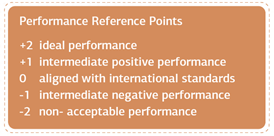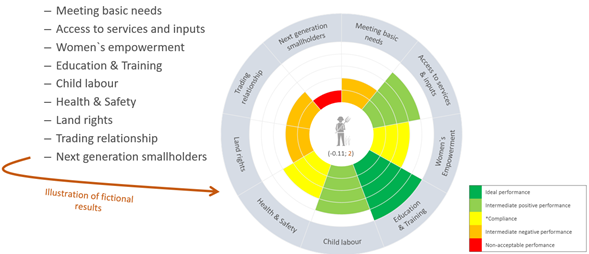Small but Complex: Integrating Smallholders within the Handbook for Product Social Impact Assessments
The aim of this article is to give a brief insight into how a new stakeholder group “Smallholders” was integrated within the current Handbook for Product Social Impact Assessments. The method was developed as part of my master`s thesis project at Aalborg University and was written in collaboration with the Roundtable for Product Social Metrics.
By Diana Indrane
Why Smallholders?
Smallholders are responsible for ~85% of world’s agriculture and are a crucial part of agriculture supply chains for many agri-food businesses. Smallholders are often characterised by a lack of resources and are regarded as a socially vulnerable. However, when it comes to assessing social impacts on Smallholders, the current Handbook has a limited capacity to do so. Until now, the Handbook addresses 3 stakeholder groups – workers, local communities and consumers – and evaluates social issues more suited to larger companies with management systems in place. Whereas, Smallholders should be considered as small entrepreneurs and associated with a different set of social issues. Prompted by Nestlé and Solvay joining the Roundtable for Product Social Metrics for Phase 4, work was undertaken to develop a method tailored specifically to Smallholders.
What do we strive to protect?
In order to define the most relevant social issues which to include in the method, Livelihoods of smallholders was chosen as the area of protection. Improving livelihoods of smallholders is one of the pillars in securing supply chains and a key area of importance for businesses. That is, by involving smallholders in the supply chains and enhancing their livelihood conditions, companies can potentially secure a long-term supply of goods. Thus, the selection of social topics and performance indicators was guided by the various assets and capabilities that smallholders can draw upon to make a living. How to define an ‘Ideal performance’? In the Handbook, each selected social topic is presented together with 2 impact assessment approaches for assessing social impacts at product level: quantitative and scale-based approach. The impact assessment methods are crucial for interpreting the collected performance indicators and supporting the decision-making process.

Figure 1 – Generic approach presented in the Handbook for Product Social Metrics, (Fontes, 2016)
In the scales-based approach, data is interpreted, and scores are attributed to each social topic in relation to a scale (Figure 1). However, defining ‘Ideal’ and ‘Positive’ performance is not clear-cut and a question was raised on how to best approach this task. What should the method for Smallholders benchmark the performance against? Oftentimes, the ideal performance is considering as the best practice and in the Handbook, it often addresses avoidance and prevention of risks. Nevertheless, for the smallholder method, a decision was made move away from the ’Risk avoidance’ mindset and focus on value creation within the product supply chains. Therefore, the assessment of positive performance in the proposed method focuses on whether supply chain actors are promoting good practices, carrying out interventions to improve working conditions for smallholders and whether the undertaken interventions are creating positive value for smallholders. This approach aims to assess the effort and will of supply chain actors to manage given social issues. Thus, answering the question ‘Are the supply chain actors able to make improvements and are they willing to?’. Hence, to achieve an ideal performance, value chain actors will need to actively contribute.
Towards consistent reference scales: Theory of Change
As each intervention undertaken by the value chain actors can be measured at different points along an impact pathway, a decision was made to focus on certain points for each level on the reference scales. That is, interventions undertaken to improve Livelihoods of smallholders were linked with a Theory of Change. The aim of doing this was to provide means for establishing consistent reference scales. Figure 2 below displays generic, high-level theory of change and example for social topic “Education and training”.

Figure 2 Theory of Change
The link between the carried-out activities and their immediate effects are relatively easy to recognise, however, this link is harder to acknowledge if performance is measured further down the impact pathway. Hence, the ‘Ideal’ performance is assessed as an output e.g. the number of Smallholders adopting better practices. Whereas, ‘Intermediate positive’ performance is assessed as inputs and activities e.g. training. In order to assess outputs, the proposed scales evaluate Smallholders` experience and satisfaction with the undertaken interventions and application of though practices. The proposed approach aims to give voice to the affected stakeholder group. Moreover, the scales consider whether good practices are supplemented by continuous improvements and reporting of the best practices.
Proposed method for Smallholders
Altogether 9 social topics were selected for stakeholder group Smallholders:

Relatively limited number of social topics were selected to keep the method manageable for companies, simple and transparent. However, the selected topics allow examination of the key social issues associated with smallholder production systems.
Learning through cases
In collaboration with Nestlé and Solvay, the proposed method was tested on 2 different case studies, assessing coffee and guar production. Both studies analysed real-life cases and aimed to gain insights on feasibility and applicability of the method. As it was a first attempt at assessing social impacts on Smallholders within this framework, learning about the proposed smallholder method was the most crucial factor of success in both cases. The method proved to be a useful framework for analysing the readily available data at the companies. It provided a systematic way of compiling the collected data points. The scale-based approach allowed to assess both negative and positive performance within the production step and helped to identify potential hotspots. Nevertheless, numerous opportunities for improvements were identified. A clear guidance on how to manage potential overlaps among the social topics is needed, and there may be a need to reconsider the importance of social topic Health and Safety. Moreover, the assessment process highlighted the performance indicators and social topics that may be challenging due to lack of data. For example, food security is a complex assessment and lacks generic data sources.
Next steps
It is recommended to test the quantitative impact assessment approach on case studies and review the proposed method externally. Furthermore, it is suggested to test the proposed methodology to cases studies covering the whole product lifecycle. It may be desirable to test the method on more complex products where multiple raw materials are sourced from smallholders. It would also allow to gain a better understanding of how to reach smallholders when supply chains are not fully visible. Moreover, during the development of the Smallholder method, it became clear that the indicators and reference scales that were developed in the initial Handbook could benefit from an update based on the Theory of Change. The update could provide consistency in the evaluation of positive impacts. You can read the complete thesishere. If you are interested in this topic or in Social Product Impacts in general do not hesitate to contact us. In the literature, Theory of Change (ToC) is defined as “A causal flow that illustrates how a proposed set of interventions and inputs will result in specific outputs contributing to different outcomes leading to certain impacts.”(Sustainable Food Lab, 2014)
